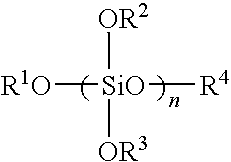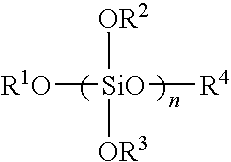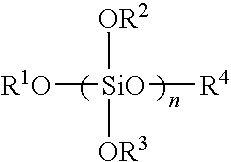Coating composition
- Summary
- Abstract
- Description
- Claims
- Application Information
AI Technical Summary
Benefits of technology
Problems solved by technology
Method used
Image
Examples
synthesis example 1
Synthesis of Resin 1
[0098]Usual equipment for preparing polyester resin equipped with a heater, stirrer, refluxing device, water separator, rectifier and thermometer was used. To a polymerization reactor were charged:
Trimethylolpropane11.14 partsNeopentylglycol38.05 partsPhthalic anhydride41.38 partsAdipic acid24.16 parts
and the mixture was heated. After melting of the starting materials, stirring was initiated and a reaction temperature was elevated to 230° C. and was maintained at 230° C. for two hours. Generated water by condensation was distilled off through the rectifier to the outside of a reaction system. Then, 6 parts of solvent naphtha was charged in the reactor, and the reaction system was shifted to a solvent condensation method and the reaction was continued. When the acid value reached 2 mgKOH / g, the reaction was terminated and the reactor was cooled. After the cooling, 56 parts of solvent naphtha 100 was added to obtain a solution of polyester Resin 1 having a solid co...
synthesis example 2
Synthesis of Resin 2
[0099]A solution of polyester Resin 2 having a solid content of 75% was prepared in the same manner as in Synthesis Example 1 except that the composition of charged components was changed to one mentioned below.
Trimethylolpropane 9.14 partsNeopentylglycol38.05 partsIsophthalic acid43.38 partsAdipic acid24.16 parts
[0100]The hydroxyl value of the obtained Resin 2 was 66 mgKOH / g and the number average molecular weight thereof was about 2,500.
synthesis example 3
[0101]Into a 200 ml four-necked flask equipped with a stirrer, thermometer and dropping funnel were poured 71 g (0.38 mol) of 2,2,3,4,4,4-hexafluorobutanol (available from DAIKIN INDUSTRIES, LTD., hereinafter referred to as “6FB”), 0.64 g (0.04 mol) of ion exchange water and 0.29 g of 35% hydrochloric acid, and then 147 g of MKC Silicate MS56 (methyl silicate available from MITSUBISHI CHEMICAL CORPORATION, decamer in average) was poured in the flask with stirring. After one-hour refluxing, components having a low boiling point were distilled off. When flowing out of a distillate stopped, the flask was cooled and ammonia gas was blown into the flask for neutralization. After completion of the neutralization, the remaining 6FB and methanol were removed under reduced pressure. After the cooling, the reaction solution was filtered to obtain 174 g of a transparent colorless liquid. According to 13C-NMR analysis of the obtained reaction product (hereinafter referred to as “FS11”), it was ...
PUM
| Property | Measurement | Unit |
|---|---|---|
| Percent by mass | aaaaa | aaaaa |
| Percent by mass | aaaaa | aaaaa |
| Percent by mass | aaaaa | aaaaa |
Abstract
Description
Claims
Application Information
 Login to View More
Login to View More - R&D
- Intellectual Property
- Life Sciences
- Materials
- Tech Scout
- Unparalleled Data Quality
- Higher Quality Content
- 60% Fewer Hallucinations
Browse by: Latest US Patents, China's latest patents, Technical Efficacy Thesaurus, Application Domain, Technology Topic, Popular Technical Reports.
© 2025 PatSnap. All rights reserved.Legal|Privacy policy|Modern Slavery Act Transparency Statement|Sitemap|About US| Contact US: help@patsnap.com



